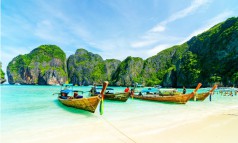



















Sunday, May 26, 2024 10:00 [IST]
Last Update: Sunday, May 26, 2024 04:25 [IST]
The Trans-Himalayan range spans the breathtaking landscapes of South Asia, serving not just as a geological wonder but also as a treasure trove of cultural, ecological, and historical significance. Yet, beneath its majestic allure lies a labyrinth of challenges demanding urgent attention and solutions. From environmental degradation to geopolitical complexities, the shared heritage of the Trans-Himalayan region confronts a myriad of obstacles that necessitate unified action for resolution. The Trans-Himalayan region, amidst the towering peaks of the Himalayas, has been a cradle of civilization for millennia. This enigmatic land, characterized by its rugged terrain and breathtaking vistas, has witnessed the ebb and flow of cultures, kingdoms, and civilizations throughout history. From the ancient trade routes that connected the East and West to the spiritual pilgrimage sites revered by millions, the history of the Trans-Himalayan region is a testament to the resilience and ingenuity of its people.
Early
Civilizations:
The history of
the Trans-Himalayan region dates back to antiquity, with evidence of human
habitation dating as far back as the Paleolithic era. The early inhabitants of
this region were nomadic hunter-gatherers who roamed the vast expanse in search
of sustenance. Over time, as agricultural practices developed, settlements
began to emerge along the fertile river valleys, laying the foundations for the
first civilizations to take root. The spread of Buddhism from neighboring
regions further enriched the spiritual landscape of the Trans Himalayan Region
giving rise to magnificent monasteries and religious institutions that became
centers of learning and pilgrimage.
Trade Routes
and Cultural Exchange:
The
Trans-Himalayan region has long served as a crossroads of civilizations, with
ancient trade routes crisscrossing its rugged terrain. The famous Silk Road,
which connected the civilizations of East and West, passed through this region,
bringing with it a rich tapestry of cultural influences from China, India,
Central Asia, and beyond. The exchange of goods, ideas, and technologies along
these trade routes fostered a vibrant cultural mosaic, shaping the identity of
the region and its people.
Colonial
Encounters and Modernization:
The arrival of
European colonial powers in the Indian subcontinent in the 19th century brought
significant changes to the Trans-Himalayan region. The British Empire, seeking
to consolidate its control over the Indian Himalayas, established strategic
outposts and trade routes, leading to increased interaction with the indigenous
communities of the region. The impact of colonialism, coupled with
modernization efforts, brought about profound social, economic, and political
transformations, reshaping the traditional way of life in the Trans-Himalayan
region.
Contemporary
Challenges and Preservation Efforts:
In the modern
era, the Trans-Himalayan region continues to grapple with a myriad of
challenges, including environmental degradation, socio-economic disparities,
and geopolitical tensions. Rapid urbanization, infrastructure development, and
climate change pose significant threats to the fragile ecosystem of the
Himalayas, while socio-economic inequalities persist despite efforts to promote
inclusive development. However, amidst these challenges, there are concerted
efforts to preserve and promote the rich cultural heritage of the Trans-Himalayan
Region.
Ecological
Concerns:
One of the
foremost issues plaguing the Trans-Himalayan region is environmental
degradation. Rapid urbanization, deforestation, and unsustainable tourism
practices have taken a toll on the fragile ecosystem of this area. The melting
glaciers, exacerbated by climate change, pose a significant threat not only to
biodiversity but also to the livelihoods of millions of people dependent on the
rivers originating from these mountains. Conservation efforts must prioritize
preserving the delicate balance of the Trans-Himalayan ecology to safeguard its
invaluable biodiversity and mitigate the adverse effects of climate change.
Cultural
Heritage Preservation:
The
Trans-Himalayan range is a melting pot of diverse cultures, traditions, and
languages. However, rapid modernization and socio-economic changes have led to
the erosion of traditional practices and knowledge systems. Indigenous
communities, who have inhabited these regions for generations, face challenges
in preserving their cultural heritage amidst globalization and external
influences. Efforts to document, protect, and promote the unique cultural
heritage of the Trans-Himalayan people are imperative to ensure its continuity
for future generations.
Socio-Economic
Development Disparities:
The
Trans-Himalayan region is characterized by stark socio-economic disparities,
with remote and marginalized communities often facing limited access to basic
services such as healthcare, education, and infrastructure. Poverty,
unemployment, and lack of economic opportunities further exacerbate these
disparities, leading to social inequalities and migration to urban centers.
Sustainable development initiatives that prioritize inclusive growth, empower
local communities, and promote equitable access to resources are crucial to
addressing socio-economic disparities and fostering resilient communities in
the Trans-Himalayan region.
Conclusion:
The
Trans-Himalayan civilization stands as a testament to human resilience,
creativity, and adaptability in overcoming challenges. Across epochs, from
ancient empires to contemporary communities, the inhabitants have cultivated a
diverse cultural heritage that evokes wonder and respect. As we confront the
complexities of the modern era, it is incumbent upon the region's people to
unite in preserving this invaluable legacy for the enjoyment and reverence of
generations yet to come.
(vidhukayastha@gmail.com)
